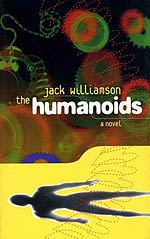
![]() Ryan F
Ryan F
3/14/2012
![]()
......We learn that the Humanoids were created over ten thousand years in the future, after humanity has spread across the stars and created scores of different planetary cultures (this background isn’t very apparent in the original story, though in both we do learn that the robots were created after a devastating war on the planet Wing IV). The planet Starmont is in a sort of cold war with the totalitarian Triplanet Powers. In his finest speculative moment, Williamson comments on the burgeoning Cold War by warning that “threatened with the inevitable fruit of its own exported know-how, the democratic republic was already sacrificing democracy as it armed itself desperately.” The technology in question is rhodomagnetics, which is like magnetism, but works on interstellar distances and allows Williamson to break Einsteinian laws of physics whenever necessary.
Our protagonist is Dr. Clay Forester, the world’s foremost expert on rhodomagnetics. At the beginning of the novel, a group of powerful psychics, including a young girl who can teleport vast distances named Jane Carter, contact Forester and warn him that the humanoids are coming. Forester is skeptical of psychic phenomena and wary that these strangers know so much of his research. When the humanoids do land, Forester does little; they are around to help after all, and they promise to remove the threat of the Triplanet Alliance. Then, they begin forbidding science (which could be used to make weapons) and drugging people who are hostile or depressed, including Forester’s neglected wife. Forester’s only hope to defeat the humanoids is to turn to the team of psychics and attempt to unlock the powers within his own mind.
Yep, it’s psychics versus robots! And it gets weirder from there. I’m not sure if it’s just theeverything-including-the-kitchen-sink nature of Golden Age sf (John Campbell’s fingerprints are all over this story – he was a big fan of “unleashing the psychic powers of the human mind” stories), or maybe it’s a case of a serialized story going off the tracks due to lack of planning, but this is a real mess. The pacing is bizarre, as Williamson zips by the key moments (like the humanoid takeover of Starmont society); characters disappear (the entire psychic team mostly fades away after an elaborate introduction – wherefore art thou, Graystone the Great?); and plotlines are foreshadowed without paying off (there are lots of hints about the mysterious origin of Forester’s friend Ironsmith, but he’s really just a robot-loving, wife-stealing jerk). The ending is also a bit of a mess – there’s some intentional ambiguity, but there also seems to be some confusion about the political message.
However, despite this messiness, I really enjoyed this book. It juggles interesting concepts and has some big sf set-piece moments. Overall, the book has a real “anything goes” Big Idea attitude that is both its greatest virtue and failure.
http://sfwinners.blogspot.com/2012/03/1949-humanoids-by-jack-williamson.html